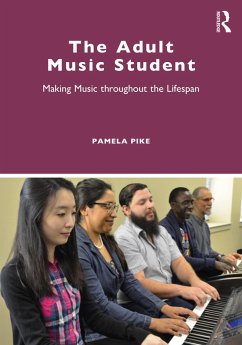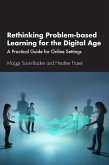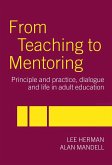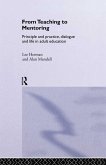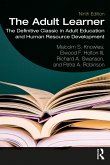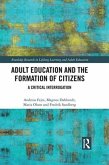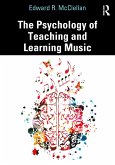- Broschiertes Buch
- Merkliste
- Auf die Merkliste
- Bewerten Bewerten
- Teilen
- Produkt teilen
- Produkterinnerung
- Produkterinnerung
In music, while coaching groups of adults in ensemble settings and teaching them in the independent studio is a longstanding tradition, most tertiary-level music courses do not address the specific issues associated with teaching adults. The Adult Music Student addresses this gap, equipping music educators and professional musicians with the skills to provide optimal learning environments for adult music-makers, and exploring the process of learning and making music across the entire adult lifespan.
In chapters rooted in research and real-world experience, adult learning theory, assumptions…mehr
Andere Kunden interessierten sich auch für
![Rethinking Problem-based Learning for the Digital Age Rethinking Problem-based Learning for the Digital Age]() Maggi Savin-BadenRethinking Problem-based Learning for the Digital Age37,99 €
Maggi Savin-BadenRethinking Problem-based Learning for the Digital Age37,99 €![From Teaching to Mentoring From Teaching to Mentoring]() Lee HermanFrom Teaching to Mentoring51,99 €
Lee HermanFrom Teaching to Mentoring51,99 €![From Teaching to Mentoring From Teaching to Mentoring]() Lee HermanFrom Teaching to Mentoring152,99 €
Lee HermanFrom Teaching to Mentoring152,99 €![The Adult Learner The Adult Learner]() Malcolm KnowlesThe Adult Learner87,99 €
Malcolm KnowlesThe Adult Learner87,99 €![Adult Education and the Formation of Citizens Adult Education and the Formation of Citizens]() Andreas FejesAdult Education and the Formation of Citizens152,99 €
Andreas FejesAdult Education and the Formation of Citizens152,99 €![The Psychology of Teaching and Learning Music The Psychology of Teaching and Learning Music]() Edward R. McClellanThe Psychology of Teaching and Learning Music38,99 €
Edward R. McClellanThe Psychology of Teaching and Learning Music38,99 €![The Adult Learner The Adult Learner]() Malcolm KnowlesThe Adult Learner91,99 €
Malcolm KnowlesThe Adult Learner91,99 €-
-
-
In music, while coaching groups of adults in ensemble settings and teaching them in the independent studio is a longstanding tradition, most tertiary-level music courses do not address the specific issues associated with teaching adults. The Adult Music Student addresses this gap, equipping music educators and professional musicians with the skills to provide optimal learning environments for adult music-makers, and exploring the process of learning and making music across the entire adult lifespan.
In chapters rooted in research and real-world experience, adult learning theory, assumptions and philosophy are presented within the context of musical situations. The author also addresses adult motivation, teacher attributes that facilitate learning, and specific strategies to engage adults at different psychosocial or developmental stages. Providing practitioners with both an understanding of how adults learn, and practical approaches that can be used immediately in various music settings, this book offers an essential guide for any instructor working with adult music students.
In chapters rooted in research and real-world experience, adult learning theory, assumptions and philosophy are presented within the context of musical situations. The author also addresses adult motivation, teacher attributes that facilitate learning, and specific strategies to engage adults at different psychosocial or developmental stages. Providing practitioners with both an understanding of how adults learn, and practical approaches that can be used immediately in various music settings, this book offers an essential guide for any instructor working with adult music students.
Produktdetails
- Produktdetails
- Verlag: Routledge / Taylor & Francis
- Seitenzahl: 164
- Erscheinungstermin: 31. Dezember 2021
- Englisch
- Abmessung: 254mm x 178mm x 9mm
- Gewicht: 453g
- ISBN-13: 9780367434588
- ISBN-10: 036743458X
- Artikelnr.: 62571480
- Herstellerkennzeichnung
- Libri GmbH
- Europaallee 1
- 36244 Bad Hersfeld
- gpsr@libri.de
- Verlag: Routledge / Taylor & Francis
- Seitenzahl: 164
- Erscheinungstermin: 31. Dezember 2021
- Englisch
- Abmessung: 254mm x 178mm x 9mm
- Gewicht: 453g
- ISBN-13: 9780367434588
- ISBN-10: 036743458X
- Artikelnr.: 62571480
- Herstellerkennzeichnung
- Libri GmbH
- Europaallee 1
- 36244 Bad Hersfeld
- gpsr@libri.de
Pamela D. Pike is the Herndon Spillman Professor of Piano Pedagogy at Louisiana State University.
Dedication
Forthcoming
List of Figures
Organization of the Book
Acknowledgements
Table of Contents
Prelude: Introduction to Making Music Throughout the Lifespan
Introduction
Section One: Characteristics of Adult Learners: Andragogy, Lifespan Development, Physical Traits & Cognition
Chapter 1: Learning Music as an Adult: Andragogy in Action
Opening Vignette
68-year-old Semi-retired Therapist and Aspiring Pianist
Introduction
Andragogy 101
Instructor as Facilitator
Considerations for the Music Studio
Need to Know, Self-Concept and Prior Musical Experiences
Max, the violinist
Readiness, Orientation and Motivation to Learn
Chloe, the pianist
Conclusions
Andragogy in Action
Notes
References
Chapter 2: Contemporary Adults Making Music: Process or Product?
Opening Vignette
Cassie: 58-year-old Guitarist
Introduction
Learning Throughout Adulthood
Nonformal Learning
Informal Learning
Formal Learning
Lifelong Learning and Serious Leisure Learning
Motivation for Learning: Process versus Product
Performance Can Be a Goal
Transformational Learning
Conclusions
Andragogy in Action
References
Chapter 3: Lifespan Development and Learning Theory: Does Life Stage Matter?
Opening Vignette
Lucy: 65-year-old Retired Librarian
Introduction
Developmental Stages of Adults and Lifespan Theory
Psychosocial Lifespan Stages for Music Participation
Musicking Across the Lifespan
Conclusions
Andragogy in Action
References
Chapter 4: Cognition & Processing: Similarities and Differences Across the Lifespan
Opening Vignettes
Elizabeth: Cello Student in her Late 60s
Dottie: Piano Student in her 70s
Introduction to Cognition and Learning
Perception and Attention
Processing: Working Memory
Long-Term Memory and Retrieval
Memory and Aging
Plasticity
Fluid and crystallized Intelligence
Word Recall and Processing Text, Prose and Speech
Stimulating Plasticity
Adapting for the Aging Brain in the Music Studio
Conclusions
Andragogy in Action
References
Chapter 5: Physical Skills and Abilities: Age-related Changes That Impact Music Learning and Participation
Opening Vignette
Anjelica: Cellist in her late 70s
Introduction
Knowing Through the Body: Embodied or Somatic Learning
Spirituality in Adult Learning and Music Making
Physical Changes as We Age
Physical Characteristics of Emerging and Young Adults
Physical Characteristics of Mid-age Adults
Physical Characteristics of Third-age Adults
Physical Characteristics of the Fourth Age
Practical Application in the Music Studio
Conclusions
Andragogy in Action
Notes
References
Section Two: Motivation in Adult Music Learning
Chapter 6: Wlodkowski, Houle, Knowles and Adult Motivation to Learn
Opening Vignettes
Sherry: Divorced Piano Student in her 50s
Susan: Married Piano Student in her 50s
Introduction
Motivation Theories to Frame Adult Motivation to Pursue Musical Activities
Intrinsic Motivation, Competence and Autonomy
Creating Meaningful Learning Experiences
Identifying an Adult's Orientation to Learning Taps into Personal Motivation
Barriers to Motivation During Adulthood
McClusky's Theory of Power-Load-Margin
Conclusions
Andragogy in Action
Notes
References
Chapter 7: Technology as a Tool for Self-Directed and Assisted Music Learning
Opening Vignettes
Excerpts from Emails of Adults Taking an Asynchronous Online Piano Course
Introduction
Synchronous Lessons: Enhancing Accessibility
Adults Taking Online Lessons
Technology to Assist with In-Person and Synchronous Online Learning
Technology to Enhance Student Learning
Informal and Nonformal Independent Learning: Providing Accessible Resources
Informal and Nonformal Learning
Asynchronous Music learning
Conclusions
Andragogy in Action
Notes
References
Chapter 8: Facilitating Learning: Learning Contracts, Negotiating Learning Outcomes and Reframing Musical Goals
Opening Vignette
Rebecca: Retired Administrative Assistant, Age 62
Introduction
Unravelling Rebecca's Comments
Preparing the Adult Learner for Music Study
First Contact and Interview
Private Studio
Group Classes and Ensembles
Discovering Goals for Music Study
The Facilitator's Goals for Students
Co-creating the Learning Plan
Conclusions
Andragogy in Action
References
Chapter 9: Methods, Music and More: Do These Matter with Adults?
Opening Vignette
Laura: 20-year Piano Class Participant
Adult Music Materials
Editions and Levelling
Supplemental Accompaniments and Backing Tracks
Beginning Methods
Duets and Ensemble Music
Various Anthologies and Specialized Skill Books
Evaluating Materials for Adult Lessons and Classes
Conclusions
Andragogy in Action
References
Section Three: Strategies to Facilitate Adult Music Making & Learning Across the Lifespan
Chapter 10: Qualities of Outstanding Adult Music Facilitators and Leaders
Opening Vignette
Bill: 41-year-old Nurse
Doug: 45-year-old Choral Conductor
Introduction
Common Characteristics of Effective Facilitators
Expertise
Respect, Empathy and Flexibility
Clarity
Conclusions
Andragogy in Action
References
Chapter 11: Private Lessons in the Second Age
Opening Vignettes
Carli: Young Adult and Intermediate Flutist
Jon: Mid-age Adult and Beginning Tenor Singer
The Second Age of Adulthood
Considerations for Working with Emerging and Mid-aged Adults
Conclusions
Andragogy in Action
References
Chapter 12: Group Lessons in the Second Age
Opening Vignettes
Beginning Piano Class for Pre-retirement Adults
Sforzando Singers: Young Adult Performing Ensemble
Working with Second-age Adult in Group Settings
Classes
Ensembles and Rehearsals
Conclusions
Andragogy in Action
References
Chapter 13: Private Lessons in the Third Age and Beyond
Opening Vignettes
Ted: 83-year-old Retired Engineer and Piano Enthusiast
Sandra: 61-year-old Cellist Taking Online Lessons
Common Experiences of Music Study
Effective Facilitation on the Private Music Lessons
The Role of Personality, Life Experiences and Age-Related Declines in Private Music Study
Personality and Preferred Learning Styles
Life Experiences
Age-related Declines
Quality of Musical Performance During the Third Age
Exits
Conclusions
Andragogy in Action
References
Chapter 14: Group Lessons and Music Making in the Third Age and Beyond
Opening Vignettes
Third-age Piano Class: A (Mostly) Serious Group
Fourth-age Singing Group: Making Music in Assisted Living
Themes Common in Effective Group Music0Making Experiences for Older Adults
Musical, Physical and Cognitive Impairment
Psychosocial Improvement and Increased Motivation
Effective Group Facilitation Strategies Employed in Older Musical Groups
Conclusions
Andragogy in Action
References
Coda: The Facilitator's Lifespan
Opening Vignette
Jane: 20-year Adult Music Educators
Introduction
Preventing Burnout
Reconnect with Your Instrument
Learn Something New
Move (Preferably Outside)
Engage with Teachers in Your Community
Take Well-planned Breaks
Seek Professional Help as Needed
Conclusions
Closing Vignette
Quote from Nancy's Diary: 68-year-old Retired Therapist and Aspiring Pianist
Andragogy in Action
References
Full Reference List
Index
Forthcoming
List of Figures
Organization of the Book
Acknowledgements
Table of Contents
Prelude: Introduction to Making Music Throughout the Lifespan
Introduction
Section One: Characteristics of Adult Learners: Andragogy, Lifespan Development, Physical Traits & Cognition
Chapter 1: Learning Music as an Adult: Andragogy in Action
Opening Vignette
68-year-old Semi-retired Therapist and Aspiring Pianist
Introduction
Andragogy 101
Instructor as Facilitator
Considerations for the Music Studio
Need to Know, Self-Concept and Prior Musical Experiences
Max, the violinist
Readiness, Orientation and Motivation to Learn
Chloe, the pianist
Conclusions
Andragogy in Action
Notes
References
Chapter 2: Contemporary Adults Making Music: Process or Product?
Opening Vignette
Cassie: 58-year-old Guitarist
Introduction
Learning Throughout Adulthood
Nonformal Learning
Informal Learning
Formal Learning
Lifelong Learning and Serious Leisure Learning
Motivation for Learning: Process versus Product
Performance Can Be a Goal
Transformational Learning
Conclusions
Andragogy in Action
References
Chapter 3: Lifespan Development and Learning Theory: Does Life Stage Matter?
Opening Vignette
Lucy: 65-year-old Retired Librarian
Introduction
Developmental Stages of Adults and Lifespan Theory
Psychosocial Lifespan Stages for Music Participation
Musicking Across the Lifespan
Conclusions
Andragogy in Action
References
Chapter 4: Cognition & Processing: Similarities and Differences Across the Lifespan
Opening Vignettes
Elizabeth: Cello Student in her Late 60s
Dottie: Piano Student in her 70s
Introduction to Cognition and Learning
Perception and Attention
Processing: Working Memory
Long-Term Memory and Retrieval
Memory and Aging
Plasticity
Fluid and crystallized Intelligence
Word Recall and Processing Text, Prose and Speech
Stimulating Plasticity
Adapting for the Aging Brain in the Music Studio
Conclusions
Andragogy in Action
References
Chapter 5: Physical Skills and Abilities: Age-related Changes That Impact Music Learning and Participation
Opening Vignette
Anjelica: Cellist in her late 70s
Introduction
Knowing Through the Body: Embodied or Somatic Learning
Spirituality in Adult Learning and Music Making
Physical Changes as We Age
Physical Characteristics of Emerging and Young Adults
Physical Characteristics of Mid-age Adults
Physical Characteristics of Third-age Adults
Physical Characteristics of the Fourth Age
Practical Application in the Music Studio
Conclusions
Andragogy in Action
Notes
References
Section Two: Motivation in Adult Music Learning
Chapter 6: Wlodkowski, Houle, Knowles and Adult Motivation to Learn
Opening Vignettes
Sherry: Divorced Piano Student in her 50s
Susan: Married Piano Student in her 50s
Introduction
Motivation Theories to Frame Adult Motivation to Pursue Musical Activities
Intrinsic Motivation, Competence and Autonomy
Creating Meaningful Learning Experiences
Identifying an Adult's Orientation to Learning Taps into Personal Motivation
Barriers to Motivation During Adulthood
McClusky's Theory of Power-Load-Margin
Conclusions
Andragogy in Action
Notes
References
Chapter 7: Technology as a Tool for Self-Directed and Assisted Music Learning
Opening Vignettes
Excerpts from Emails of Adults Taking an Asynchronous Online Piano Course
Introduction
Synchronous Lessons: Enhancing Accessibility
Adults Taking Online Lessons
Technology to Assist with In-Person and Synchronous Online Learning
Technology to Enhance Student Learning
Informal and Nonformal Independent Learning: Providing Accessible Resources
Informal and Nonformal Learning
Asynchronous Music learning
Conclusions
Andragogy in Action
Notes
References
Chapter 8: Facilitating Learning: Learning Contracts, Negotiating Learning Outcomes and Reframing Musical Goals
Opening Vignette
Rebecca: Retired Administrative Assistant, Age 62
Introduction
Unravelling Rebecca's Comments
Preparing the Adult Learner for Music Study
First Contact and Interview
Private Studio
Group Classes and Ensembles
Discovering Goals for Music Study
The Facilitator's Goals for Students
Co-creating the Learning Plan
Conclusions
Andragogy in Action
References
Chapter 9: Methods, Music and More: Do These Matter with Adults?
Opening Vignette
Laura: 20-year Piano Class Participant
Adult Music Materials
Editions and Levelling
Supplemental Accompaniments and Backing Tracks
Beginning Methods
Duets and Ensemble Music
Various Anthologies and Specialized Skill Books
Evaluating Materials for Adult Lessons and Classes
Conclusions
Andragogy in Action
References
Section Three: Strategies to Facilitate Adult Music Making & Learning Across the Lifespan
Chapter 10: Qualities of Outstanding Adult Music Facilitators and Leaders
Opening Vignette
Bill: 41-year-old Nurse
Doug: 45-year-old Choral Conductor
Introduction
Common Characteristics of Effective Facilitators
Expertise
Respect, Empathy and Flexibility
Clarity
Conclusions
Andragogy in Action
References
Chapter 11: Private Lessons in the Second Age
Opening Vignettes
Carli: Young Adult and Intermediate Flutist
Jon: Mid-age Adult and Beginning Tenor Singer
The Second Age of Adulthood
Considerations for Working with Emerging and Mid-aged Adults
Conclusions
Andragogy in Action
References
Chapter 12: Group Lessons in the Second Age
Opening Vignettes
Beginning Piano Class for Pre-retirement Adults
Sforzando Singers: Young Adult Performing Ensemble
Working with Second-age Adult in Group Settings
Classes
Ensembles and Rehearsals
Conclusions
Andragogy in Action
References
Chapter 13: Private Lessons in the Third Age and Beyond
Opening Vignettes
Ted: 83-year-old Retired Engineer and Piano Enthusiast
Sandra: 61-year-old Cellist Taking Online Lessons
Common Experiences of Music Study
Effective Facilitation on the Private Music Lessons
The Role of Personality, Life Experiences and Age-Related Declines in Private Music Study
Personality and Preferred Learning Styles
Life Experiences
Age-related Declines
Quality of Musical Performance During the Third Age
Exits
Conclusions
Andragogy in Action
References
Chapter 14: Group Lessons and Music Making in the Third Age and Beyond
Opening Vignettes
Third-age Piano Class: A (Mostly) Serious Group
Fourth-age Singing Group: Making Music in Assisted Living
Themes Common in Effective Group Music0Making Experiences for Older Adults
Musical, Physical and Cognitive Impairment
Psychosocial Improvement and Increased Motivation
Effective Group Facilitation Strategies Employed in Older Musical Groups
Conclusions
Andragogy in Action
References
Coda: The Facilitator's Lifespan
Opening Vignette
Jane: 20-year Adult Music Educators
Introduction
Preventing Burnout
Reconnect with Your Instrument
Learn Something New
Move (Preferably Outside)
Engage with Teachers in Your Community
Take Well-planned Breaks
Seek Professional Help as Needed
Conclusions
Closing Vignette
Quote from Nancy's Diary: 68-year-old Retired Therapist and Aspiring Pianist
Andragogy in Action
References
Full Reference List
Index
Dedication
Forthcoming
List of Figures
Organization of the Book
Acknowledgements
Table of Contents
Prelude: Introduction to Making Music Throughout the Lifespan
Introduction
Section One: Characteristics of Adult Learners: Andragogy, Lifespan
Development, Physical Traits & Cognition
Chapter 1: Learning Music as an Adult: Andragogy in Action
Opening Vignette
68-year-old Semi-retired Therapist and Aspiring Pianist
Introduction
Andragogy 101
Instructor as Facilitator
Considerations for the Music Studio
Need to Know, Self-Concept and Prior Musical Experiences
Max, the violinist
Readiness, Orientation and Motivation to Learn
Chloe, the pianist
Conclusions
Andragogy in Action
Notes
References
Chapter 2: Contemporary Adults Making Music: Process or Product?
Opening Vignette
Cassie: 58-year-old Guitarist
Introduction
Learning Throughout Adulthood
Nonformal Learning
Informal Learning
Formal Learning
Lifelong Learning and Serious Leisure Learning
Motivation for Learning: Process versus Product
Performance Can Be a Goal
Transformational Learning
Conclusions
Andragogy in Action
References
Chapter 3: Lifespan Development and Learning Theory: Does Life Stage
Matter?
Opening Vignette
Lucy: 65-year-old Retired Librarian
Introduction
Developmental Stages of Adults and Lifespan Theory
Psychosocial Lifespan Stages for Music Participation
Musicking Across the Lifespan
Conclusions
Andragogy in Action
References
Chapter 4: Cognition & Processing: Similarities and Differences Across the
Lifespan
Opening Vignettes
Elizabeth: Cello Student in her Late 60s
Dottie: Piano Student in her 70s
Introduction to Cognition and Learning
Perception and Attention
Processing: Working Memory
Long-Term Memory and Retrieval
Memory and Aging
Plasticity
Fluid and crystallized Intelligence
Word Recall and Processing Text, Prose and Speech
Stimulating Plasticity
Adapting for the Aging Brain in the Music Studio
Conclusions
Andragogy in Action
References
Chapter 5: Physical Skills and Abilities: Age-related Changes That Impact
Music Learning and Participation
Opening Vignette
Anjelica: Cellist in her late 70s
Introduction
Knowing Through the Body: Embodied or Somatic Learning
Spirituality in Adult Learning and Music Making
Physical Changes as We Age
Physical Characteristics of Emerging and Young Adults
Physical Characteristics of Mid-age Adults
Physical Characteristics of Third-age Adults
Physical Characteristics of the Fourth Age
Practical Application in the Music Studio
Conclusions
Andragogy in Action
Notes
References
Section Two: Motivation in Adult Music Learning
Chapter 6: Wlodkowski, Houle, Knowles and Adult Motivation to Learn
Opening Vignettes
Sherry: Divorced Piano Student in her 50s
Susan: Married Piano Student in her 50s
Introduction
Motivation Theories to Frame Adult Motivation to Pursue Musical Activities
Intrinsic Motivation, Competence and Autonomy
Creating Meaningful Learning Experiences
Identifying an Adult's Orientation to Learning Taps into Personal
Motivation
Barriers to Motivation During Adulthood
McClusky's Theory of Power-Load-Margin
Conclusions
Andragogy in Action
Notes
References
Chapter 7: Technology as a Tool for Self-Directed and Assisted Music
Learning
Opening Vignettes
Excerpts from Emails of Adults Taking an Asynchronous Online Piano Course
Introduction
Synchronous Lessons: Enhancing Accessibility
Adults Taking Online Lessons
Technology to Assist with In-Person and Synchronous Online Learning
Technology to Enhance Student Learning
Informal and Nonformal Independent Learning: Providing Accessible Resources
Informal and Nonformal Learning
Asynchronous Music learning
Conclusions
Andragogy in Action
Notes
References
Chapter 8: Facilitating Learning: Learning Contracts, Negotiating Learning
Outcomes and Reframing Musical Goals
Opening Vignette
Rebecca: Retired Administrative Assistant, Age 62
Introduction
Unravelling Rebecca's Comments
Preparing the Adult Learner for Music Study
First Contact and Interview
Private Studio
Group Classes and Ensembles
Discovering Goals for Music Study
The Facilitator's Goals for Students
Co-creating the Learning Plan
Conclusions
Andragogy in Action
References
Chapter 9: Methods, Music and More: Do These Matter with Adults?
Opening Vignette
Laura: 20-year Piano Class Participant
Adult Music Materials
Editions and Levelling
Supplemental Accompaniments and Backing Tracks
Beginning Methods
Duets and Ensemble Music
Various Anthologies and Specialized Skill Books
Evaluating Materials for Adult Lessons and Classes
Conclusions
Andragogy in Action
References
Section Three: Strategies to Facilitate Adult Music Making & Learning
Across the Lifespan
Chapter 10: Qualities of Outstanding Adult Music Facilitators and Leaders
Opening Vignette
Bill: 41-year-old Nurse
Doug: 45-year-old Choral Conductor
Introduction
Common Characteristics of Effective Facilitators
Expertise
Respect, Empathy and Flexibility
Clarity
Conclusions
Andragogy in Action
References
Chapter 11: Private Lessons in the Second Age
Opening Vignettes
Carli: Young Adult and Intermediate Flutist
Jon: Mid-age Adult and Beginning Tenor Singer
The Second Age of Adulthood
Considerations for Working with Emerging and Mid-aged Adults
Conclusions
Andragogy in Action
References
Chapter 12: Group Lessons in the Second Age
Opening Vignettes
Beginning Piano Class for Pre-retirement Adults
Sforzando Singers: Young Adult Performing Ensemble
Working with Second-age Adult in Group Settings
Classes
Ensembles and Rehearsals
Conclusions
Andragogy in Action
References
Chapter 13: Private Lessons in the Third Age and Beyond
Opening Vignettes
Ted: 83-year-old Retired Engineer and Piano Enthusiast
Sandra: 61-year-old Cellist Taking Online Lessons
Common Experiences of Music Study
Effective Facilitation on the Private Music Lessons
The Role of Personality, Life Experiences and Age-Related Declines in
Private Music Study
Personality and Preferred Learning Styles
Life Experiences
Age-related Declines
Quality of Musical Performance During the Third Age
Exits
Conclusions
Andragogy in Action
References
Chapter 14: Group Lessons and Music Making in the Third Age and Beyond
Opening Vignettes
Third-age Piano Class: A (Mostly) Serious Group
Fourth-age Singing Group: Making Music in Assisted Living
Themes Common in Effective Group Music0Making Experiences for Older Adults
Musical, Physical and Cognitive Impairment
Psychosocial Improvement and Increased Motivation
Effective Group Facilitation Strategies Employed in Older Musical Groups
Conclusions
Andragogy in Action
References
Coda: The Facilitator's Lifespan
Opening Vignette
Jane: 20-year Adult Music Educators
Introduction
Preventing Burnout
Reconnect with Your Instrument
Learn Something New
Move (Preferably Outside)
Engage with Teachers in Your Community
Take Well-planned Breaks
Seek Professional Help as Needed
Conclusions
Closing Vignette
Quote from Nancy's Diary: 68-year-old Retired Therapist and Aspiring
Pianist
Andragogy in Action
References
Full Reference List
Index
Forthcoming
List of Figures
Organization of the Book
Acknowledgements
Table of Contents
Prelude: Introduction to Making Music Throughout the Lifespan
Introduction
Section One: Characteristics of Adult Learners: Andragogy, Lifespan
Development, Physical Traits & Cognition
Chapter 1: Learning Music as an Adult: Andragogy in Action
Opening Vignette
68-year-old Semi-retired Therapist and Aspiring Pianist
Introduction
Andragogy 101
Instructor as Facilitator
Considerations for the Music Studio
Need to Know, Self-Concept and Prior Musical Experiences
Max, the violinist
Readiness, Orientation and Motivation to Learn
Chloe, the pianist
Conclusions
Andragogy in Action
Notes
References
Chapter 2: Contemporary Adults Making Music: Process or Product?
Opening Vignette
Cassie: 58-year-old Guitarist
Introduction
Learning Throughout Adulthood
Nonformal Learning
Informal Learning
Formal Learning
Lifelong Learning and Serious Leisure Learning
Motivation for Learning: Process versus Product
Performance Can Be a Goal
Transformational Learning
Conclusions
Andragogy in Action
References
Chapter 3: Lifespan Development and Learning Theory: Does Life Stage
Matter?
Opening Vignette
Lucy: 65-year-old Retired Librarian
Introduction
Developmental Stages of Adults and Lifespan Theory
Psychosocial Lifespan Stages for Music Participation
Musicking Across the Lifespan
Conclusions
Andragogy in Action
References
Chapter 4: Cognition & Processing: Similarities and Differences Across the
Lifespan
Opening Vignettes
Elizabeth: Cello Student in her Late 60s
Dottie: Piano Student in her 70s
Introduction to Cognition and Learning
Perception and Attention
Processing: Working Memory
Long-Term Memory and Retrieval
Memory and Aging
Plasticity
Fluid and crystallized Intelligence
Word Recall and Processing Text, Prose and Speech
Stimulating Plasticity
Adapting for the Aging Brain in the Music Studio
Conclusions
Andragogy in Action
References
Chapter 5: Physical Skills and Abilities: Age-related Changes That Impact
Music Learning and Participation
Opening Vignette
Anjelica: Cellist in her late 70s
Introduction
Knowing Through the Body: Embodied or Somatic Learning
Spirituality in Adult Learning and Music Making
Physical Changes as We Age
Physical Characteristics of Emerging and Young Adults
Physical Characteristics of Mid-age Adults
Physical Characteristics of Third-age Adults
Physical Characteristics of the Fourth Age
Practical Application in the Music Studio
Conclusions
Andragogy in Action
Notes
References
Section Two: Motivation in Adult Music Learning
Chapter 6: Wlodkowski, Houle, Knowles and Adult Motivation to Learn
Opening Vignettes
Sherry: Divorced Piano Student in her 50s
Susan: Married Piano Student in her 50s
Introduction
Motivation Theories to Frame Adult Motivation to Pursue Musical Activities
Intrinsic Motivation, Competence and Autonomy
Creating Meaningful Learning Experiences
Identifying an Adult's Orientation to Learning Taps into Personal
Motivation
Barriers to Motivation During Adulthood
McClusky's Theory of Power-Load-Margin
Conclusions
Andragogy in Action
Notes
References
Chapter 7: Technology as a Tool for Self-Directed and Assisted Music
Learning
Opening Vignettes
Excerpts from Emails of Adults Taking an Asynchronous Online Piano Course
Introduction
Synchronous Lessons: Enhancing Accessibility
Adults Taking Online Lessons
Technology to Assist with In-Person and Synchronous Online Learning
Technology to Enhance Student Learning
Informal and Nonformal Independent Learning: Providing Accessible Resources
Informal and Nonformal Learning
Asynchronous Music learning
Conclusions
Andragogy in Action
Notes
References
Chapter 8: Facilitating Learning: Learning Contracts, Negotiating Learning
Outcomes and Reframing Musical Goals
Opening Vignette
Rebecca: Retired Administrative Assistant, Age 62
Introduction
Unravelling Rebecca's Comments
Preparing the Adult Learner for Music Study
First Contact and Interview
Private Studio
Group Classes and Ensembles
Discovering Goals for Music Study
The Facilitator's Goals for Students
Co-creating the Learning Plan
Conclusions
Andragogy in Action
References
Chapter 9: Methods, Music and More: Do These Matter with Adults?
Opening Vignette
Laura: 20-year Piano Class Participant
Adult Music Materials
Editions and Levelling
Supplemental Accompaniments and Backing Tracks
Beginning Methods
Duets and Ensemble Music
Various Anthologies and Specialized Skill Books
Evaluating Materials for Adult Lessons and Classes
Conclusions
Andragogy in Action
References
Section Three: Strategies to Facilitate Adult Music Making & Learning
Across the Lifespan
Chapter 10: Qualities of Outstanding Adult Music Facilitators and Leaders
Opening Vignette
Bill: 41-year-old Nurse
Doug: 45-year-old Choral Conductor
Introduction
Common Characteristics of Effective Facilitators
Expertise
Respect, Empathy and Flexibility
Clarity
Conclusions
Andragogy in Action
References
Chapter 11: Private Lessons in the Second Age
Opening Vignettes
Carli: Young Adult and Intermediate Flutist
Jon: Mid-age Adult and Beginning Tenor Singer
The Second Age of Adulthood
Considerations for Working with Emerging and Mid-aged Adults
Conclusions
Andragogy in Action
References
Chapter 12: Group Lessons in the Second Age
Opening Vignettes
Beginning Piano Class for Pre-retirement Adults
Sforzando Singers: Young Adult Performing Ensemble
Working with Second-age Adult in Group Settings
Classes
Ensembles and Rehearsals
Conclusions
Andragogy in Action
References
Chapter 13: Private Lessons in the Third Age and Beyond
Opening Vignettes
Ted: 83-year-old Retired Engineer and Piano Enthusiast
Sandra: 61-year-old Cellist Taking Online Lessons
Common Experiences of Music Study
Effective Facilitation on the Private Music Lessons
The Role of Personality, Life Experiences and Age-Related Declines in
Private Music Study
Personality and Preferred Learning Styles
Life Experiences
Age-related Declines
Quality of Musical Performance During the Third Age
Exits
Conclusions
Andragogy in Action
References
Chapter 14: Group Lessons and Music Making in the Third Age and Beyond
Opening Vignettes
Third-age Piano Class: A (Mostly) Serious Group
Fourth-age Singing Group: Making Music in Assisted Living
Themes Common in Effective Group Music0Making Experiences for Older Adults
Musical, Physical and Cognitive Impairment
Psychosocial Improvement and Increased Motivation
Effective Group Facilitation Strategies Employed in Older Musical Groups
Conclusions
Andragogy in Action
References
Coda: The Facilitator's Lifespan
Opening Vignette
Jane: 20-year Adult Music Educators
Introduction
Preventing Burnout
Reconnect with Your Instrument
Learn Something New
Move (Preferably Outside)
Engage with Teachers in Your Community
Take Well-planned Breaks
Seek Professional Help as Needed
Conclusions
Closing Vignette
Quote from Nancy's Diary: 68-year-old Retired Therapist and Aspiring
Pianist
Andragogy in Action
References
Full Reference List
Index
Dedication
Forthcoming
List of Figures
Organization of the Book
Acknowledgements
Table of Contents
Prelude: Introduction to Making Music Throughout the Lifespan
Introduction
Section One: Characteristics of Adult Learners: Andragogy, Lifespan Development, Physical Traits & Cognition
Chapter 1: Learning Music as an Adult: Andragogy in Action
Opening Vignette
68-year-old Semi-retired Therapist and Aspiring Pianist
Introduction
Andragogy 101
Instructor as Facilitator
Considerations for the Music Studio
Need to Know, Self-Concept and Prior Musical Experiences
Max, the violinist
Readiness, Orientation and Motivation to Learn
Chloe, the pianist
Conclusions
Andragogy in Action
Notes
References
Chapter 2: Contemporary Adults Making Music: Process or Product?
Opening Vignette
Cassie: 58-year-old Guitarist
Introduction
Learning Throughout Adulthood
Nonformal Learning
Informal Learning
Formal Learning
Lifelong Learning and Serious Leisure Learning
Motivation for Learning: Process versus Product
Performance Can Be a Goal
Transformational Learning
Conclusions
Andragogy in Action
References
Chapter 3: Lifespan Development and Learning Theory: Does Life Stage Matter?
Opening Vignette
Lucy: 65-year-old Retired Librarian
Introduction
Developmental Stages of Adults and Lifespan Theory
Psychosocial Lifespan Stages for Music Participation
Musicking Across the Lifespan
Conclusions
Andragogy in Action
References
Chapter 4: Cognition & Processing: Similarities and Differences Across the Lifespan
Opening Vignettes
Elizabeth: Cello Student in her Late 60s
Dottie: Piano Student in her 70s
Introduction to Cognition and Learning
Perception and Attention
Processing: Working Memory
Long-Term Memory and Retrieval
Memory and Aging
Plasticity
Fluid and crystallized Intelligence
Word Recall and Processing Text, Prose and Speech
Stimulating Plasticity
Adapting for the Aging Brain in the Music Studio
Conclusions
Andragogy in Action
References
Chapter 5: Physical Skills and Abilities: Age-related Changes That Impact Music Learning and Participation
Opening Vignette
Anjelica: Cellist in her late 70s
Introduction
Knowing Through the Body: Embodied or Somatic Learning
Spirituality in Adult Learning and Music Making
Physical Changes as We Age
Physical Characteristics of Emerging and Young Adults
Physical Characteristics of Mid-age Adults
Physical Characteristics of Third-age Adults
Physical Characteristics of the Fourth Age
Practical Application in the Music Studio
Conclusions
Andragogy in Action
Notes
References
Section Two: Motivation in Adult Music Learning
Chapter 6: Wlodkowski, Houle, Knowles and Adult Motivation to Learn
Opening Vignettes
Sherry: Divorced Piano Student in her 50s
Susan: Married Piano Student in her 50s
Introduction
Motivation Theories to Frame Adult Motivation to Pursue Musical Activities
Intrinsic Motivation, Competence and Autonomy
Creating Meaningful Learning Experiences
Identifying an Adult's Orientation to Learning Taps into Personal Motivation
Barriers to Motivation During Adulthood
McClusky's Theory of Power-Load-Margin
Conclusions
Andragogy in Action
Notes
References
Chapter 7: Technology as a Tool for Self-Directed and Assisted Music Learning
Opening Vignettes
Excerpts from Emails of Adults Taking an Asynchronous Online Piano Course
Introduction
Synchronous Lessons: Enhancing Accessibility
Adults Taking Online Lessons
Technology to Assist with In-Person and Synchronous Online Learning
Technology to Enhance Student Learning
Informal and Nonformal Independent Learning: Providing Accessible Resources
Informal and Nonformal Learning
Asynchronous Music learning
Conclusions
Andragogy in Action
Notes
References
Chapter 8: Facilitating Learning: Learning Contracts, Negotiating Learning Outcomes and Reframing Musical Goals
Opening Vignette
Rebecca: Retired Administrative Assistant, Age 62
Introduction
Unravelling Rebecca's Comments
Preparing the Adult Learner for Music Study
First Contact and Interview
Private Studio
Group Classes and Ensembles
Discovering Goals for Music Study
The Facilitator's Goals for Students
Co-creating the Learning Plan
Conclusions
Andragogy in Action
References
Chapter 9: Methods, Music and More: Do These Matter with Adults?
Opening Vignette
Laura: 20-year Piano Class Participant
Adult Music Materials
Editions and Levelling
Supplemental Accompaniments and Backing Tracks
Beginning Methods
Duets and Ensemble Music
Various Anthologies and Specialized Skill Books
Evaluating Materials for Adult Lessons and Classes
Conclusions
Andragogy in Action
References
Section Three: Strategies to Facilitate Adult Music Making & Learning Across the Lifespan
Chapter 10: Qualities of Outstanding Adult Music Facilitators and Leaders
Opening Vignette
Bill: 41-year-old Nurse
Doug: 45-year-old Choral Conductor
Introduction
Common Characteristics of Effective Facilitators
Expertise
Respect, Empathy and Flexibility
Clarity
Conclusions
Andragogy in Action
References
Chapter 11: Private Lessons in the Second Age
Opening Vignettes
Carli: Young Adult and Intermediate Flutist
Jon: Mid-age Adult and Beginning Tenor Singer
The Second Age of Adulthood
Considerations for Working with Emerging and Mid-aged Adults
Conclusions
Andragogy in Action
References
Chapter 12: Group Lessons in the Second Age
Opening Vignettes
Beginning Piano Class for Pre-retirement Adults
Sforzando Singers: Young Adult Performing Ensemble
Working with Second-age Adult in Group Settings
Classes
Ensembles and Rehearsals
Conclusions
Andragogy in Action
References
Chapter 13: Private Lessons in the Third Age and Beyond
Opening Vignettes
Ted: 83-year-old Retired Engineer and Piano Enthusiast
Sandra: 61-year-old Cellist Taking Online Lessons
Common Experiences of Music Study
Effective Facilitation on the Private Music Lessons
The Role of Personality, Life Experiences and Age-Related Declines in Private Music Study
Personality and Preferred Learning Styles
Life Experiences
Age-related Declines
Quality of Musical Performance During the Third Age
Exits
Conclusions
Andragogy in Action
References
Chapter 14: Group Lessons and Music Making in the Third Age and Beyond
Opening Vignettes
Third-age Piano Class: A (Mostly) Serious Group
Fourth-age Singing Group: Making Music in Assisted Living
Themes Common in Effective Group Music0Making Experiences for Older Adults
Musical, Physical and Cognitive Impairment
Psychosocial Improvement and Increased Motivation
Effective Group Facilitation Strategies Employed in Older Musical Groups
Conclusions
Andragogy in Action
References
Coda: The Facilitator's Lifespan
Opening Vignette
Jane: 20-year Adult Music Educators
Introduction
Preventing Burnout
Reconnect with Your Instrument
Learn Something New
Move (Preferably Outside)
Engage with Teachers in Your Community
Take Well-planned Breaks
Seek Professional Help as Needed
Conclusions
Closing Vignette
Quote from Nancy's Diary: 68-year-old Retired Therapist and Aspiring Pianist
Andragogy in Action
References
Full Reference List
Index
Forthcoming
List of Figures
Organization of the Book
Acknowledgements
Table of Contents
Prelude: Introduction to Making Music Throughout the Lifespan
Introduction
Section One: Characteristics of Adult Learners: Andragogy, Lifespan Development, Physical Traits & Cognition
Chapter 1: Learning Music as an Adult: Andragogy in Action
Opening Vignette
68-year-old Semi-retired Therapist and Aspiring Pianist
Introduction
Andragogy 101
Instructor as Facilitator
Considerations for the Music Studio
Need to Know, Self-Concept and Prior Musical Experiences
Max, the violinist
Readiness, Orientation and Motivation to Learn
Chloe, the pianist
Conclusions
Andragogy in Action
Notes
References
Chapter 2: Contemporary Adults Making Music: Process or Product?
Opening Vignette
Cassie: 58-year-old Guitarist
Introduction
Learning Throughout Adulthood
Nonformal Learning
Informal Learning
Formal Learning
Lifelong Learning and Serious Leisure Learning
Motivation for Learning: Process versus Product
Performance Can Be a Goal
Transformational Learning
Conclusions
Andragogy in Action
References
Chapter 3: Lifespan Development and Learning Theory: Does Life Stage Matter?
Opening Vignette
Lucy: 65-year-old Retired Librarian
Introduction
Developmental Stages of Adults and Lifespan Theory
Psychosocial Lifespan Stages for Music Participation
Musicking Across the Lifespan
Conclusions
Andragogy in Action
References
Chapter 4: Cognition & Processing: Similarities and Differences Across the Lifespan
Opening Vignettes
Elizabeth: Cello Student in her Late 60s
Dottie: Piano Student in her 70s
Introduction to Cognition and Learning
Perception and Attention
Processing: Working Memory
Long-Term Memory and Retrieval
Memory and Aging
Plasticity
Fluid and crystallized Intelligence
Word Recall and Processing Text, Prose and Speech
Stimulating Plasticity
Adapting for the Aging Brain in the Music Studio
Conclusions
Andragogy in Action
References
Chapter 5: Physical Skills and Abilities: Age-related Changes That Impact Music Learning and Participation
Opening Vignette
Anjelica: Cellist in her late 70s
Introduction
Knowing Through the Body: Embodied or Somatic Learning
Spirituality in Adult Learning and Music Making
Physical Changes as We Age
Physical Characteristics of Emerging and Young Adults
Physical Characteristics of Mid-age Adults
Physical Characteristics of Third-age Adults
Physical Characteristics of the Fourth Age
Practical Application in the Music Studio
Conclusions
Andragogy in Action
Notes
References
Section Two: Motivation in Adult Music Learning
Chapter 6: Wlodkowski, Houle, Knowles and Adult Motivation to Learn
Opening Vignettes
Sherry: Divorced Piano Student in her 50s
Susan: Married Piano Student in her 50s
Introduction
Motivation Theories to Frame Adult Motivation to Pursue Musical Activities
Intrinsic Motivation, Competence and Autonomy
Creating Meaningful Learning Experiences
Identifying an Adult's Orientation to Learning Taps into Personal Motivation
Barriers to Motivation During Adulthood
McClusky's Theory of Power-Load-Margin
Conclusions
Andragogy in Action
Notes
References
Chapter 7: Technology as a Tool for Self-Directed and Assisted Music Learning
Opening Vignettes
Excerpts from Emails of Adults Taking an Asynchronous Online Piano Course
Introduction
Synchronous Lessons: Enhancing Accessibility
Adults Taking Online Lessons
Technology to Assist with In-Person and Synchronous Online Learning
Technology to Enhance Student Learning
Informal and Nonformal Independent Learning: Providing Accessible Resources
Informal and Nonformal Learning
Asynchronous Music learning
Conclusions
Andragogy in Action
Notes
References
Chapter 8: Facilitating Learning: Learning Contracts, Negotiating Learning Outcomes and Reframing Musical Goals
Opening Vignette
Rebecca: Retired Administrative Assistant, Age 62
Introduction
Unravelling Rebecca's Comments
Preparing the Adult Learner for Music Study
First Contact and Interview
Private Studio
Group Classes and Ensembles
Discovering Goals for Music Study
The Facilitator's Goals for Students
Co-creating the Learning Plan
Conclusions
Andragogy in Action
References
Chapter 9: Methods, Music and More: Do These Matter with Adults?
Opening Vignette
Laura: 20-year Piano Class Participant
Adult Music Materials
Editions and Levelling
Supplemental Accompaniments and Backing Tracks
Beginning Methods
Duets and Ensemble Music
Various Anthologies and Specialized Skill Books
Evaluating Materials for Adult Lessons and Classes
Conclusions
Andragogy in Action
References
Section Three: Strategies to Facilitate Adult Music Making & Learning Across the Lifespan
Chapter 10: Qualities of Outstanding Adult Music Facilitators and Leaders
Opening Vignette
Bill: 41-year-old Nurse
Doug: 45-year-old Choral Conductor
Introduction
Common Characteristics of Effective Facilitators
Expertise
Respect, Empathy and Flexibility
Clarity
Conclusions
Andragogy in Action
References
Chapter 11: Private Lessons in the Second Age
Opening Vignettes
Carli: Young Adult and Intermediate Flutist
Jon: Mid-age Adult and Beginning Tenor Singer
The Second Age of Adulthood
Considerations for Working with Emerging and Mid-aged Adults
Conclusions
Andragogy in Action
References
Chapter 12: Group Lessons in the Second Age
Opening Vignettes
Beginning Piano Class for Pre-retirement Adults
Sforzando Singers: Young Adult Performing Ensemble
Working with Second-age Adult in Group Settings
Classes
Ensembles and Rehearsals
Conclusions
Andragogy in Action
References
Chapter 13: Private Lessons in the Third Age and Beyond
Opening Vignettes
Ted: 83-year-old Retired Engineer and Piano Enthusiast
Sandra: 61-year-old Cellist Taking Online Lessons
Common Experiences of Music Study
Effective Facilitation on the Private Music Lessons
The Role of Personality, Life Experiences and Age-Related Declines in Private Music Study
Personality and Preferred Learning Styles
Life Experiences
Age-related Declines
Quality of Musical Performance During the Third Age
Exits
Conclusions
Andragogy in Action
References
Chapter 14: Group Lessons and Music Making in the Third Age and Beyond
Opening Vignettes
Third-age Piano Class: A (Mostly) Serious Group
Fourth-age Singing Group: Making Music in Assisted Living
Themes Common in Effective Group Music0Making Experiences for Older Adults
Musical, Physical and Cognitive Impairment
Psychosocial Improvement and Increased Motivation
Effective Group Facilitation Strategies Employed in Older Musical Groups
Conclusions
Andragogy in Action
References
Coda: The Facilitator's Lifespan
Opening Vignette
Jane: 20-year Adult Music Educators
Introduction
Preventing Burnout
Reconnect with Your Instrument
Learn Something New
Move (Preferably Outside)
Engage with Teachers in Your Community
Take Well-planned Breaks
Seek Professional Help as Needed
Conclusions
Closing Vignette
Quote from Nancy's Diary: 68-year-old Retired Therapist and Aspiring Pianist
Andragogy in Action
References
Full Reference List
Index
Dedication
Forthcoming
List of Figures
Organization of the Book
Acknowledgements
Table of Contents
Prelude: Introduction to Making Music Throughout the Lifespan
Introduction
Section One: Characteristics of Adult Learners: Andragogy, Lifespan
Development, Physical Traits & Cognition
Chapter 1: Learning Music as an Adult: Andragogy in Action
Opening Vignette
68-year-old Semi-retired Therapist and Aspiring Pianist
Introduction
Andragogy 101
Instructor as Facilitator
Considerations for the Music Studio
Need to Know, Self-Concept and Prior Musical Experiences
Max, the violinist
Readiness, Orientation and Motivation to Learn
Chloe, the pianist
Conclusions
Andragogy in Action
Notes
References
Chapter 2: Contemporary Adults Making Music: Process or Product?
Opening Vignette
Cassie: 58-year-old Guitarist
Introduction
Learning Throughout Adulthood
Nonformal Learning
Informal Learning
Formal Learning
Lifelong Learning and Serious Leisure Learning
Motivation for Learning: Process versus Product
Performance Can Be a Goal
Transformational Learning
Conclusions
Andragogy in Action
References
Chapter 3: Lifespan Development and Learning Theory: Does Life Stage
Matter?
Opening Vignette
Lucy: 65-year-old Retired Librarian
Introduction
Developmental Stages of Adults and Lifespan Theory
Psychosocial Lifespan Stages for Music Participation
Musicking Across the Lifespan
Conclusions
Andragogy in Action
References
Chapter 4: Cognition & Processing: Similarities and Differences Across the
Lifespan
Opening Vignettes
Elizabeth: Cello Student in her Late 60s
Dottie: Piano Student in her 70s
Introduction to Cognition and Learning
Perception and Attention
Processing: Working Memory
Long-Term Memory and Retrieval
Memory and Aging
Plasticity
Fluid and crystallized Intelligence
Word Recall and Processing Text, Prose and Speech
Stimulating Plasticity
Adapting for the Aging Brain in the Music Studio
Conclusions
Andragogy in Action
References
Chapter 5: Physical Skills and Abilities: Age-related Changes That Impact
Music Learning and Participation
Opening Vignette
Anjelica: Cellist in her late 70s
Introduction
Knowing Through the Body: Embodied or Somatic Learning
Spirituality in Adult Learning and Music Making
Physical Changes as We Age
Physical Characteristics of Emerging and Young Adults
Physical Characteristics of Mid-age Adults
Physical Characteristics of Third-age Adults
Physical Characteristics of the Fourth Age
Practical Application in the Music Studio
Conclusions
Andragogy in Action
Notes
References
Section Two: Motivation in Adult Music Learning
Chapter 6: Wlodkowski, Houle, Knowles and Adult Motivation to Learn
Opening Vignettes
Sherry: Divorced Piano Student in her 50s
Susan: Married Piano Student in her 50s
Introduction
Motivation Theories to Frame Adult Motivation to Pursue Musical Activities
Intrinsic Motivation, Competence and Autonomy
Creating Meaningful Learning Experiences
Identifying an Adult's Orientation to Learning Taps into Personal
Motivation
Barriers to Motivation During Adulthood
McClusky's Theory of Power-Load-Margin
Conclusions
Andragogy in Action
Notes
References
Chapter 7: Technology as a Tool for Self-Directed and Assisted Music
Learning
Opening Vignettes
Excerpts from Emails of Adults Taking an Asynchronous Online Piano Course
Introduction
Synchronous Lessons: Enhancing Accessibility
Adults Taking Online Lessons
Technology to Assist with In-Person and Synchronous Online Learning
Technology to Enhance Student Learning
Informal and Nonformal Independent Learning: Providing Accessible Resources
Informal and Nonformal Learning
Asynchronous Music learning
Conclusions
Andragogy in Action
Notes
References
Chapter 8: Facilitating Learning: Learning Contracts, Negotiating Learning
Outcomes and Reframing Musical Goals
Opening Vignette
Rebecca: Retired Administrative Assistant, Age 62
Introduction
Unravelling Rebecca's Comments
Preparing the Adult Learner for Music Study
First Contact and Interview
Private Studio
Group Classes and Ensembles
Discovering Goals for Music Study
The Facilitator's Goals for Students
Co-creating the Learning Plan
Conclusions
Andragogy in Action
References
Chapter 9: Methods, Music and More: Do These Matter with Adults?
Opening Vignette
Laura: 20-year Piano Class Participant
Adult Music Materials
Editions and Levelling
Supplemental Accompaniments and Backing Tracks
Beginning Methods
Duets and Ensemble Music
Various Anthologies and Specialized Skill Books
Evaluating Materials for Adult Lessons and Classes
Conclusions
Andragogy in Action
References
Section Three: Strategies to Facilitate Adult Music Making & Learning
Across the Lifespan
Chapter 10: Qualities of Outstanding Adult Music Facilitators and Leaders
Opening Vignette
Bill: 41-year-old Nurse
Doug: 45-year-old Choral Conductor
Introduction
Common Characteristics of Effective Facilitators
Expertise
Respect, Empathy and Flexibility
Clarity
Conclusions
Andragogy in Action
References
Chapter 11: Private Lessons in the Second Age
Opening Vignettes
Carli: Young Adult and Intermediate Flutist
Jon: Mid-age Adult and Beginning Tenor Singer
The Second Age of Adulthood
Considerations for Working with Emerging and Mid-aged Adults
Conclusions
Andragogy in Action
References
Chapter 12: Group Lessons in the Second Age
Opening Vignettes
Beginning Piano Class for Pre-retirement Adults
Sforzando Singers: Young Adult Performing Ensemble
Working with Second-age Adult in Group Settings
Classes
Ensembles and Rehearsals
Conclusions
Andragogy in Action
References
Chapter 13: Private Lessons in the Third Age and Beyond
Opening Vignettes
Ted: 83-year-old Retired Engineer and Piano Enthusiast
Sandra: 61-year-old Cellist Taking Online Lessons
Common Experiences of Music Study
Effective Facilitation on the Private Music Lessons
The Role of Personality, Life Experiences and Age-Related Declines in
Private Music Study
Personality and Preferred Learning Styles
Life Experiences
Age-related Declines
Quality of Musical Performance During the Third Age
Exits
Conclusions
Andragogy in Action
References
Chapter 14: Group Lessons and Music Making in the Third Age and Beyond
Opening Vignettes
Third-age Piano Class: A (Mostly) Serious Group
Fourth-age Singing Group: Making Music in Assisted Living
Themes Common in Effective Group Music0Making Experiences for Older Adults
Musical, Physical and Cognitive Impairment
Psychosocial Improvement and Increased Motivation
Effective Group Facilitation Strategies Employed in Older Musical Groups
Conclusions
Andragogy in Action
References
Coda: The Facilitator's Lifespan
Opening Vignette
Jane: 20-year Adult Music Educators
Introduction
Preventing Burnout
Reconnect with Your Instrument
Learn Something New
Move (Preferably Outside)
Engage with Teachers in Your Community
Take Well-planned Breaks
Seek Professional Help as Needed
Conclusions
Closing Vignette
Quote from Nancy's Diary: 68-year-old Retired Therapist and Aspiring
Pianist
Andragogy in Action
References
Full Reference List
Index
Forthcoming
List of Figures
Organization of the Book
Acknowledgements
Table of Contents
Prelude: Introduction to Making Music Throughout the Lifespan
Introduction
Section One: Characteristics of Adult Learners: Andragogy, Lifespan
Development, Physical Traits & Cognition
Chapter 1: Learning Music as an Adult: Andragogy in Action
Opening Vignette
68-year-old Semi-retired Therapist and Aspiring Pianist
Introduction
Andragogy 101
Instructor as Facilitator
Considerations for the Music Studio
Need to Know, Self-Concept and Prior Musical Experiences
Max, the violinist
Readiness, Orientation and Motivation to Learn
Chloe, the pianist
Conclusions
Andragogy in Action
Notes
References
Chapter 2: Contemporary Adults Making Music: Process or Product?
Opening Vignette
Cassie: 58-year-old Guitarist
Introduction
Learning Throughout Adulthood
Nonformal Learning
Informal Learning
Formal Learning
Lifelong Learning and Serious Leisure Learning
Motivation for Learning: Process versus Product
Performance Can Be a Goal
Transformational Learning
Conclusions
Andragogy in Action
References
Chapter 3: Lifespan Development and Learning Theory: Does Life Stage
Matter?
Opening Vignette
Lucy: 65-year-old Retired Librarian
Introduction
Developmental Stages of Adults and Lifespan Theory
Psychosocial Lifespan Stages for Music Participation
Musicking Across the Lifespan
Conclusions
Andragogy in Action
References
Chapter 4: Cognition & Processing: Similarities and Differences Across the
Lifespan
Opening Vignettes
Elizabeth: Cello Student in her Late 60s
Dottie: Piano Student in her 70s
Introduction to Cognition and Learning
Perception and Attention
Processing: Working Memory
Long-Term Memory and Retrieval
Memory and Aging
Plasticity
Fluid and crystallized Intelligence
Word Recall and Processing Text, Prose and Speech
Stimulating Plasticity
Adapting for the Aging Brain in the Music Studio
Conclusions
Andragogy in Action
References
Chapter 5: Physical Skills and Abilities: Age-related Changes That Impact
Music Learning and Participation
Opening Vignette
Anjelica: Cellist in her late 70s
Introduction
Knowing Through the Body: Embodied or Somatic Learning
Spirituality in Adult Learning and Music Making
Physical Changes as We Age
Physical Characteristics of Emerging and Young Adults
Physical Characteristics of Mid-age Adults
Physical Characteristics of Third-age Adults
Physical Characteristics of the Fourth Age
Practical Application in the Music Studio
Conclusions
Andragogy in Action
Notes
References
Section Two: Motivation in Adult Music Learning
Chapter 6: Wlodkowski, Houle, Knowles and Adult Motivation to Learn
Opening Vignettes
Sherry: Divorced Piano Student in her 50s
Susan: Married Piano Student in her 50s
Introduction
Motivation Theories to Frame Adult Motivation to Pursue Musical Activities
Intrinsic Motivation, Competence and Autonomy
Creating Meaningful Learning Experiences
Identifying an Adult's Orientation to Learning Taps into Personal
Motivation
Barriers to Motivation During Adulthood
McClusky's Theory of Power-Load-Margin
Conclusions
Andragogy in Action
Notes
References
Chapter 7: Technology as a Tool for Self-Directed and Assisted Music
Learning
Opening Vignettes
Excerpts from Emails of Adults Taking an Asynchronous Online Piano Course
Introduction
Synchronous Lessons: Enhancing Accessibility
Adults Taking Online Lessons
Technology to Assist with In-Person and Synchronous Online Learning
Technology to Enhance Student Learning
Informal and Nonformal Independent Learning: Providing Accessible Resources
Informal and Nonformal Learning
Asynchronous Music learning
Conclusions
Andragogy in Action
Notes
References
Chapter 8: Facilitating Learning: Learning Contracts, Negotiating Learning
Outcomes and Reframing Musical Goals
Opening Vignette
Rebecca: Retired Administrative Assistant, Age 62
Introduction
Unravelling Rebecca's Comments
Preparing the Adult Learner for Music Study
First Contact and Interview
Private Studio
Group Classes and Ensembles
Discovering Goals for Music Study
The Facilitator's Goals for Students
Co-creating the Learning Plan
Conclusions
Andragogy in Action
References
Chapter 9: Methods, Music and More: Do These Matter with Adults?
Opening Vignette
Laura: 20-year Piano Class Participant
Adult Music Materials
Editions and Levelling
Supplemental Accompaniments and Backing Tracks
Beginning Methods
Duets and Ensemble Music
Various Anthologies and Specialized Skill Books
Evaluating Materials for Adult Lessons and Classes
Conclusions
Andragogy in Action
References
Section Three: Strategies to Facilitate Adult Music Making & Learning
Across the Lifespan
Chapter 10: Qualities of Outstanding Adult Music Facilitators and Leaders
Opening Vignette
Bill: 41-year-old Nurse
Doug: 45-year-old Choral Conductor
Introduction
Common Characteristics of Effective Facilitators
Expertise
Respect, Empathy and Flexibility
Clarity
Conclusions
Andragogy in Action
References
Chapter 11: Private Lessons in the Second Age
Opening Vignettes
Carli: Young Adult and Intermediate Flutist
Jon: Mid-age Adult and Beginning Tenor Singer
The Second Age of Adulthood
Considerations for Working with Emerging and Mid-aged Adults
Conclusions
Andragogy in Action
References
Chapter 12: Group Lessons in the Second Age
Opening Vignettes
Beginning Piano Class for Pre-retirement Adults
Sforzando Singers: Young Adult Performing Ensemble
Working with Second-age Adult in Group Settings
Classes
Ensembles and Rehearsals
Conclusions
Andragogy in Action
References
Chapter 13: Private Lessons in the Third Age and Beyond
Opening Vignettes
Ted: 83-year-old Retired Engineer and Piano Enthusiast
Sandra: 61-year-old Cellist Taking Online Lessons
Common Experiences of Music Study
Effective Facilitation on the Private Music Lessons
The Role of Personality, Life Experiences and Age-Related Declines in
Private Music Study
Personality and Preferred Learning Styles
Life Experiences
Age-related Declines
Quality of Musical Performance During the Third Age
Exits
Conclusions
Andragogy in Action
References
Chapter 14: Group Lessons and Music Making in the Third Age and Beyond
Opening Vignettes
Third-age Piano Class: A (Mostly) Serious Group
Fourth-age Singing Group: Making Music in Assisted Living
Themes Common in Effective Group Music0Making Experiences for Older Adults
Musical, Physical and Cognitive Impairment
Psychosocial Improvement and Increased Motivation
Effective Group Facilitation Strategies Employed in Older Musical Groups
Conclusions
Andragogy in Action
References
Coda: The Facilitator's Lifespan
Opening Vignette
Jane: 20-year Adult Music Educators
Introduction
Preventing Burnout
Reconnect with Your Instrument
Learn Something New
Move (Preferably Outside)
Engage with Teachers in Your Community
Take Well-planned Breaks
Seek Professional Help as Needed
Conclusions
Closing Vignette
Quote from Nancy's Diary: 68-year-old Retired Therapist and Aspiring
Pianist
Andragogy in Action
References
Full Reference List
Index

